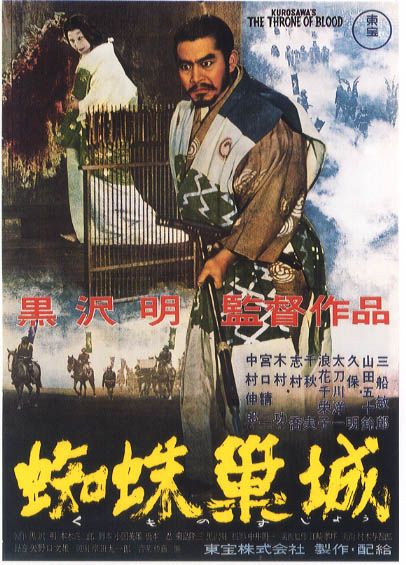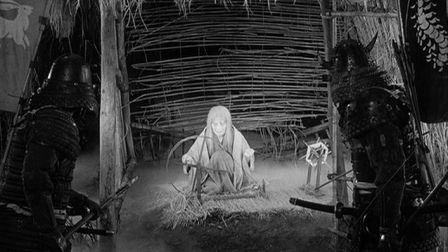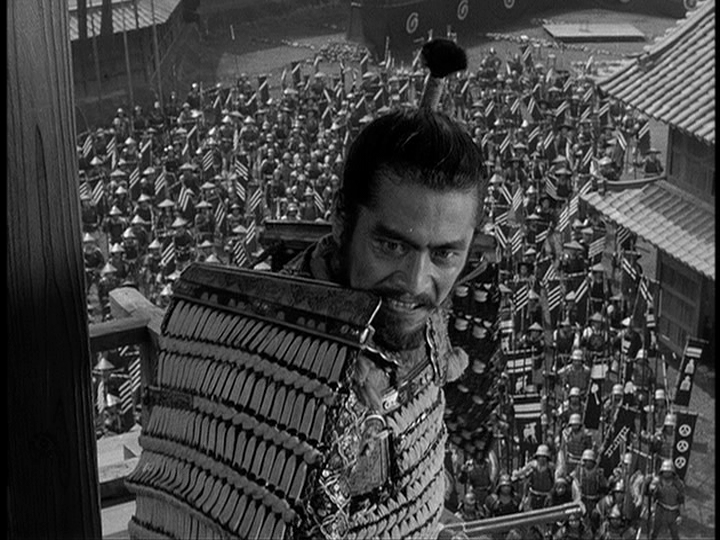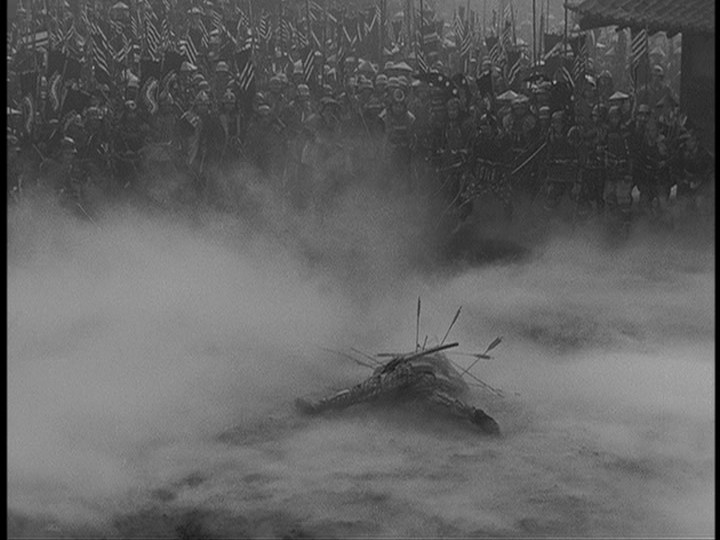Throne
of Blood (Kumonosu-jo)
1957
Director: Akira Kurosawa
Starring: Toshiro Mifune, Isuzu Yamada,
Akira Kubo
I
have a thing for Shakespeare. In
college, with a biochemistry major and an honors program minor, I had almost no
time in my schedule for electives of my choosing. In fact, I only ever chose two electives, and
it wasn’t until my senior year I had the space available in my schedule. The first elective was the standard
Shakespeare literature course the college offered (because biochemistry majors
totally need to take Shakespeare). The
second was an independent study with the professor of the aforementioned
Shakespeare course where I designed my own project. What did I design? I examined different film adaptations of
Shakespeare plays and compared them to the original texts. Again, because biochemistry majors clearly
need to do this.
I
really wish I had known about Throne of Blood back when I was
doing that independent study. It would
have been an amazing film to examine in that context.
Throne
of Blood
is Macbeth set in feudal Japan.
Warrior Washizu (Mifune) is Macbeth, and the film opens with him and his
friend Miki (Kubo), the Banquo role, riding back to their lord after finding
success in battle. They find a spirit in
the woods who tells both of future success, specifically Washizu that he will
rule the land, and tells Miki that his son will then rule the land. Both men laugh, but when the spirit’s
predictions begin to come true, the psychological battle begins. Washizu’s wife, Lady Asaji (Yamada), goads
her husband to off his superior to become high ruler. Issues of power, corruption, greed, and guilt
are explored as violence begets violence.
Of
all the Shakespeare plays, films, and various adaptations I’ve seen, Macbeth
is the play that has been presented most creatively and in many different
settings. I’ve seen it live three times,
one of which was a deaf student production with deaf actors on stage acting the
roles while speaking actors read the lines into a microphone from backstage,
and another of which was a five-person production, with little to no set
dressing and each person playing at least half a dozen parts. Things got interesting when the actor who
played Macbeth also played one of the witches – it meant the witches were
talking to nobody onstage. (Man, I’d
kill to see the current Alan Cumming one-man Macbeth on Broadway right
now… anyone want to take me to Manhattan for the weekend?) In terms of film and TV, there’s the iconic
blood-filled Polanski film version, the much more interesting Shakespeare Revisited BBC version
starring James McAvoy that transplants the action to a modern cutthroat
restaurant empire, and then there’s Throne of Blood.
And
for my money, Throne of Blood is the best of the bunch.
It
staggers me how amazingly well Shakespeare’s story, written in seventeenth
century England, translates to the feudal society of centuries-old Japan, a
place and time Shakespeare himself probably had no idea existed in the
least. The credit for this falls on two
men’s shoulders. First of all, due must
be paid to Shakespeare’s original tale, one with such universal themes that it
was carried to such an opposite place from the one he originally intended and
yet the message still remains. But Throne
of Blood would not work nearly as well as it does were it not for the
brilliance of Akira Kurosawa to understand how to translate the Bard’s tale to
his own homeland. It’s Kurosawa’s doing
that he knows how to make Macbeth fit into feudal Japan, how to swap
kings for kimonos, and Laurence Olivier for Toshiro Mifune (really, not a bad
swap). Everything that makes Macbeth
special is still here, and it’s still potent.
The three witches are transposed into a truly freaky single ghost
spirit, surrounded by fog, speaking with an unearthly hollow voice, and
constantly spinning the web of fate. The
banquet scene with Banquo’s ghost, probably my favorite scene from Macbeth
and one that HAS to be right for me in order to enjoy a Macbeth
production, is here, and just as disturbing and upsetting. The camera keeps cutting back to Banquo’s
empty chair, then back again to his pale ghost.
It’s a terrific scene, one that certainly allows Mifune to display
tremendous range as the paranoid and frightened Washizu, and just one of the
many examples of how well Shakespeare works when telling a samurai story.
The
two standout performances are that of Mifune as Washizu and, to be expected,
Yamada as Lady Asaji. Mifune is always
good, always watchable, and I prefer him playing the tragic hero, as he does
here, over playing the buffoon as he does in Seven Samurai. Sure, he yells a lot – that’s Mifune’s style
– but Mifune has range. Here, as
Washizu, he can go from scared to paranoid to frightened to angry in the span
of about thirty seconds, and it’s entirely believable. His silence is eerie after he kills the
reigning lord in his sleep and thoroughly unnerving. His death scene, as Washizu is riddled with a
ridiculous amount of arrows, is memorable to the last. (Apparently, in order to ensure the fear on
Mifune’s face was real, Kurosawa used real arrows for the shots that were not
to hit Washizu.) In short, Mifune knows how
to play Macbeth. But it’s Yamada as Lady
Asaji who really steals the show. Yamada
had great source material to work with, as Lady Macbeth is one of the most
magnificent literary villains of all time, but even so, Yamada manages to take
the evil and crank it up a few notches.
Her Asaji is frankly frightening in her cool demeanor and cutthroat
words. She barely moves a muscle as she
slowly spells out to Washizu that he must take control of his own destiny to
fulfill the spirit’s prophecy. Her
decisions to underplay nearly every scene are the perfect balance to Mifune’s
aggressive screen presence. It gives the
impression of a calm, cool, and incredibly strict master with a somewhat crazed
bulldog on a leash. The minute the
master gives the word, the bulldog will attack.
Kurosawa’s
production is beautifully imagined and photographed. Ultimately realizing it would be more
economical to just build an actual damn fortress rather than the simply façade,
Throne
of Blood is done on a grand scale.
The volcanic mountainside of Mt. Fuji is unsettlingly desolate, and the
bright fog that seems to envelop nearly every outdoor shot is deliciously
atmospheric. When the woods of Dunsinane
– or, rather, Spider Web Forest – begin to move, it’s easily the best cinematic
representation of Shakespeare’s moving forest I’ve ever seen. I love how Kurosawa presents the spirits, how
without any computer effects and purely through in-camera techniques, we get an
effective representation of other-worldly beings. The makeup, the altered voices, the flying
above Washizu in the forest paths, the disappearing and reappearing: it’s a
great interpretation. The costumes are
utterly divine as well. These are not
the poor, destitute, rural warriors of Seven Samurai, but true lords
displaying all the trappings of wealth.
If Mifune is not dressed in full armor regalia, decked to the hilt in
decorations, then he is wearing luxurious costumes full of layers and billowing
fabrics. This is a beautiful film to
watch.
Is
this the best Shakespeare adaptation I’ve ever seen? Well, that’s a big ask. I don’t know if it’s the best, but it’s
certainly one of the best, easily top five, and definitely gets the award for
Most Imaginative Transposition. This and
Ikiru
(which one I pick depends on my mood – do I want adventure or sorrow?) are my
two favorite Kurosawa films. An
absolutely brilliant film.
Arbitrary
Rating: 10/10.






God. Damn. Right.
ReplyDeleteThis is my default favorite Kurosawa film in part because MacBeth is my favorite Shakespeare. It's just so damn good. It's one of those films that I can watch whenever. I don't need to be in a mood to see people shooting arrows at Mifune.
Like you, Lady Asaji is one of my favorite parts of Kumonosu Jo. She's so eerie.
I feel like it's a bit unoriginal to say that the equivalent of Lady Macbeth is one of the best parts of the film, because it's frickin' Lady Macbeth, she's going to be amazing no matter what because of the written part, but even so, Yamada finds a way to push it farther. Even among other Lady Macbeths, she stands out.
DeleteI agree with pretty much everything you wrote. I love this film and would pick it as the best MacBeth adaptation I've seen. (fyi - This was my latest pick for the Club.)
ReplyDeleteIn regards to other interpretations of the Macbeth story, were you reading my blog when I did a series of posts on that? I reviewed Throne of Blood, a version of Macbeth set in a 1940s/1950s militaristic Scotland, and one set in a fast food restaurant in 1970s Pennsylvania. The McAvoy version you mentioned sounds like a direct ripoff of the last.
If you are interested, the parent post is here with links to each of my reviews and how they differ from one another: http://tipsfromchip.blogspot.com/2012/01/atomic-shakespeare-part-1-macbeth.html
Thanks for the parent link, I don't think I had started reading your stuff by that time. The McAvoy version might very well be a ripoff, but hey, I thought it was good.
DeleteGreat pick for the club, really great pick. Now that many others have got their Throne of Blood reviews up, I'm rather struck by the fact that pretty much everyone (at least, from what I've read) really enjoys this movie. That says something huge right there. This is a movie that, the first time I saw it, knocked me sideways, and I felt I had discovered something enormous and important and amazing. And now, with everyone else saying essentially the same thing about Throne of Blood, I realize I am definitely not alone in feeling that way.
Loved your review. You caught so many of the images that I love myself. I don't know if anyone ever topped all the fabulous things Kurosawa did with the fog, alone, in this film.
ReplyDeleteGad, the woods... and the fog... it's just breathtaking. I mean, I was already with this movie because of the narrative and the great tension and excitement brought to the table by Kurosawa, but add onto that the fantastic photography and production design, and this movie just knocks it out of the park.
Deletejordan shoes
ReplyDeletegolden goose sneakers
off white
coach bags
air max 270
yeezy boost 350
ralph lauren uk
converse shoes
nike huarache
balenciaga